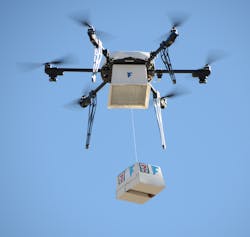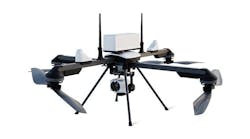A large portion of the FAA Extension, Safety, and Security Act of 2016 focused on developing regulations and programs for unmanned aircraft systems, which goes to show how these drones may be the tune of the future for aviation.
Drones aren't synonymous with only hobbyists anymore. The push to keep up with advancing technology is evident in the aviation community as a whole, as displayed in the focuses FAA Reauthorization Act, and drones are now, more than ever, a big part of that.
In an industry that seems to pull for efficiency, could drones take over? Maybe; at least partially. There's already some examples of drones eliminating steps in a process, making some ground equipment obsolete or offering a safer option.
For example, to improve efficiency of aircraft inspections and to reduce downtime, Airbus uses a drone with a high definition camera to perform visual inspections replacing the need for large equipment.
The drone, supervised by a pilot, follows a flight path around the upper part of the aircraft while taking a series of pictures. The images, up to 150, are then recorded in a database to be analyzed afterwards, or off-site.
Collecting the data by drone takes from 10 to 15 minutes, according to an Airbus news release, while the conventional method of using an inspector and telescopic handler can take around two hours.
“The use of this new technology offers better working conditions including improving the safety and comfort for the quality inspectors," Head of Quality at Airbus Nathalie Ducombeau said.
By early 2017, Airbus will implement the systematic inspection with this drone on all A330 aircraft.
Most recently, Flirtey, a drone delivery service, completed the first fully autonomous drone delivery to a customer's house in partnership with 7-Eleven.
Drone services, like Flirtey offer, can eliminate the need for other forms of delivery in favor of efficiency and less labor.
“My wife and I both work and have three small children ages seven, six and one," the Reno resident who received the Flirety delivery said. "The convenience of having access to instant, 24/7 drone delivery is priceless. It’s amazing that a flying robot just delivered us food and drinks in a matter of minutes.”
But, there are still some hiccups with drone delivery in the United States, at least for Amazon who had to start testing their parcel delivery in the U.K. because of stricter U.S. regulations.
Amazons delivery, called Prime Air, is testing the ability to fly drones beyond the line of sight, sensors that avoid and identify obstacles and a one person operation of a fleet of drones.
"The U.K. is a leader in enabling drone innovation – we've been investing in Prime Air research and development here for quite some time," Paul Misener, Amazon's vice president of global innovation policy and communications, said in a news release.


